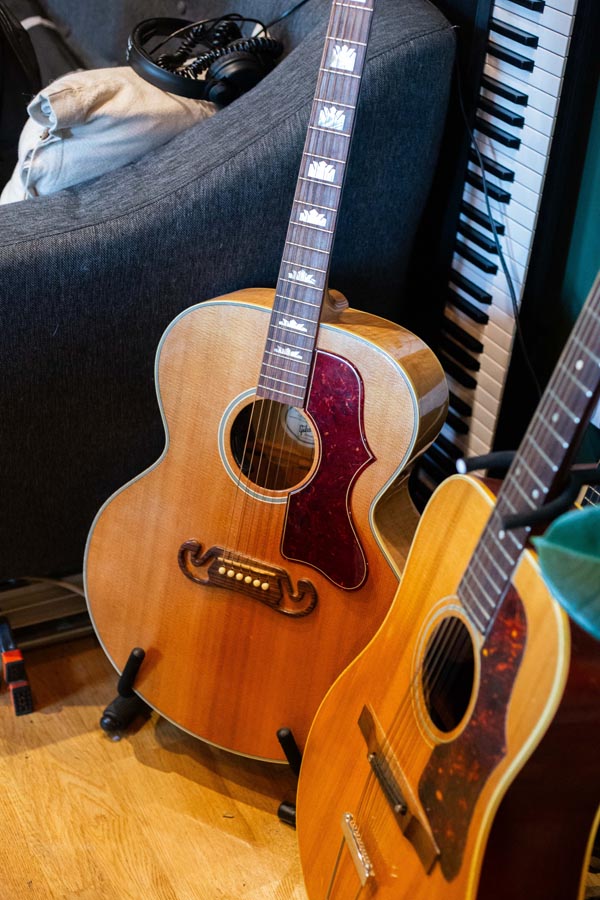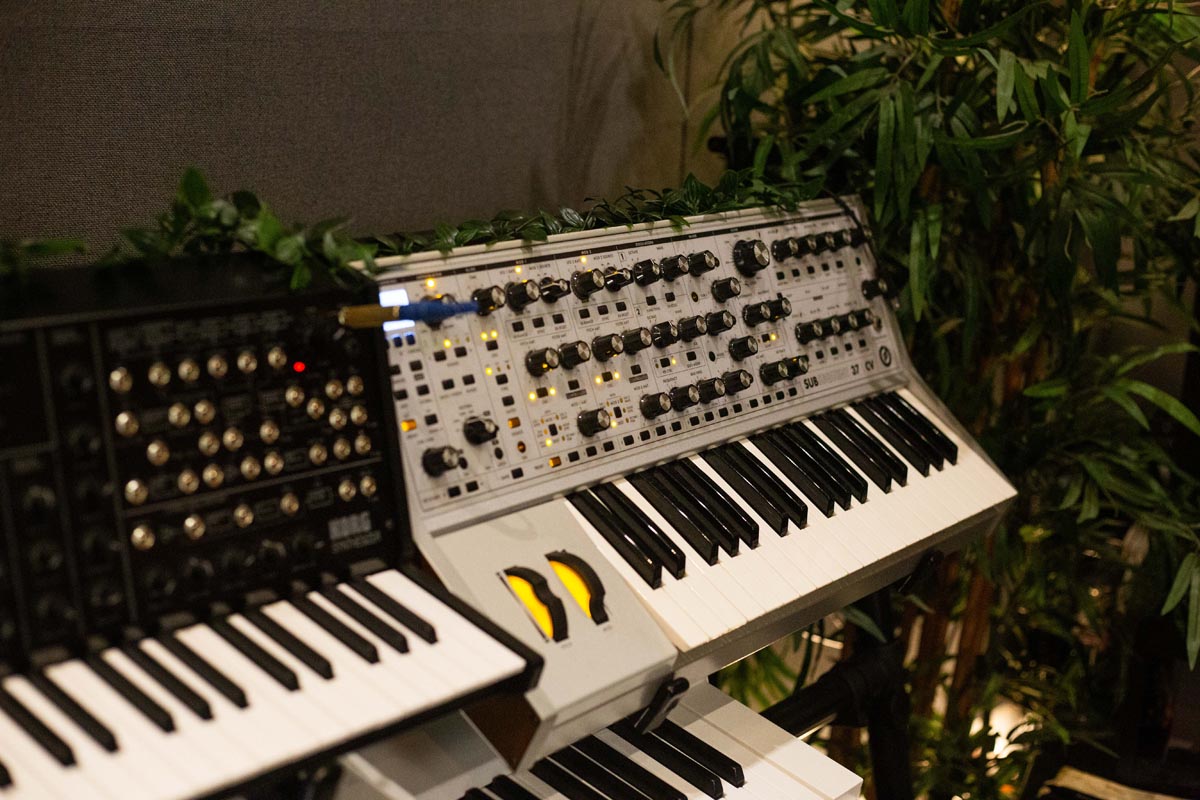Producer, musician and engineer Paul Whalley on recording, songwriting and the Lauten Audio LA-320 microphone.
Tileyard London is the city’s hottest creative hub. Boasting state-of-the-art recording studios, bars, cafes and a music venue (complete with a Dynaudio Atmos system), the home of artists like Sigala, Ella Eyre and The Prodigy is the ultimate destination for anyone deeply invested in the UK music scene.
Among its residents is accomplished songwriter and producer Paul Whalley, who recently added the Lauten Audio LA-320 v2 valve microphone to his recording setup.
Paul kindly invited us down to his studio for a chat about recording and production, and how the right microphone can help bring out the best in an artist.
Producer Paul Whalley (Tileyard London) on the Lauten Audio LA-320 Microphone
See more videos at Synthax TV
The British Library Aesthetic
“I’m a songwriter and producer here at Tileyard London,” Paul says as we sit down in his studio. A room that’s had several notable owners over the years – including once belonging to The Prodigy – Paul has been tweaking the space into its current guise, with its laidback and warm surroundings accentuated by wooden floors, red leather sofas, and an array of pot plants.
“My line was always I want it to be like the British Library – that was the aesthetic I was going for,” laughs Paul. “I want anyone who comes in here to be able to feel comfortable and relaxed, like it’s their studio as well. A lot of studios feel very expensive, but personally I’ve always preferred a more homely or casual setup.”
“And then yeah, just having things on hand that people can access,” he says reaching across to grab his latest addition, a cyan Danelectro baritone guitar. “The piano, guitars, synths, things that people can just pick up, touch, play and move around with, however they’re comfortable.”

A multi-instrumentalist, Paul’s musical talents have seen him employed as a session musician, recording engineer, songwriter and producer for a number of independent and major label UK artists.
“I’ve worked on various things over the years – a lot of production, songwriting, and mixing. People such as Alice Merton, Sigala, Lost Frequencies, The Wanted, Louis Tomlinson.
“Seeing the audience’s reactions is always a really special thing. Actually seeing how the records translate live. I’ve had the privilege a few times of seeing songs I’ve written performed in arenas and big stages, including getting to perform a couple of my own at the Royal Albert Hall last year, which was a lot of fun.”
Entering Paul’s studio you’re immediately greeted by his upright piano. The space is adorned with instruments and hardware: analogue synths, an old Akai MPC 3000 – complete with a stack of floppy disks – and an enviable collection of guitars (“Far too many, one of everything”). And then there’s his mellotron, which Paul says people just can’t wait to play with.
“Until I had this space I’d never had the joy of having a real piano in a studio, and I’ve been so surprised how that changes writing sessions,” Paul enthuses.
“I would say to anyone, have some real instruments in your studio if you can, because having the piano in here just makes people get up and move around. It’s not just everyone sat looking at lyrics on their phones all day, or staying within themselves. I also swear by my little Martin guitar for the same reason – between that and the piano, those are two of the most invaluable things to actual writing.
“The final piece of the puzzle is the Mellotron. Every song writer that comes in is either overjoyed to see it, or has never seen one and is just fascinated by it, and just loves the selection of sounds it can create. I can’t tell you how many records have started with something someone’s found or made on it, it’s so intricate-sounding, while being so simple to experiment with.”

From Wigan to London
Having started out playing the tuba in his hometown of Wigan, Paul moved to London for university before going on to work in various studio roles. In contrast to his classical background, it was actually his discovery of hip hop production that led him down the path of becoming a producer.
“Growing up I had none of that in my house – my parents listened to very little music – and I was playing in brass bands in Wigan, a proper mining town brass band haha. So discovering A Tribe Called Quest and J Dilla, artists like that, and what a drum machine was, had a huge influence on my taste in music.
“After university I sort of found my way into session musician work, and along the way discovered production and songwriting. It was very much about 10 years ago that I had a lightning bolt moment of ‘ah, that’s the job I want to do’.
“I worked a few times out of Eastcote studios, and different producers would come through, which led me to the realisation that ‘oh wow, people are sat on laptops making this stuff, I can start making this stuff at home’.

“So that, combined with my love of the more traditional record-making process and my dreams of one day having my own studio, has led me to this point, with a hybrid workflow where you can do both.”
As we continue chatting about the recording process, we wonder if there’s anything Paul thinks is missing in modern music?
“Something that I love in music, and which is coming back in a big way, is the human element,” he remarks.
“I’ve always been a huge fan of imperfections in records – like little sounds and squeaks – or just the nature of things not being perfectly in tune, or exactly in time. I think so many great records from back in the day have little imperfections or mistakes, very human grooves and feels to them.”
“It’s something I always try to find a way in for, whether it’s having some of the drum programming slightly off the grid, or played in by hand on the MPC. Or maybe I’ll have one of the writers play in a part, who might not actually be the best keyboard, piano or guitar player. Even just to find little bits I can sample or loop. I always try to find a space for something like that, because I often find they end up being the most integral parts of a song.
“Even if it’s a dance record, where everything is very square, I’ll still try to find a space where something can feel organic, maybe even a slight imperfection to it. Trying to convey a bit of realness, humanness, that’s a big thing for me.”
Hardware vs Software
Along with the many instruments at his disposal, Paul also has a selection of high-quality outboard – including an original 1178, a couple of spring reverbs and an old tape echo, which he says he’s particularly fond of.
Whilst he agrees that both hardware and software have their place in the modern studio – with Paul noting the speed that software provides as particularly powerful – he’s equally enthusiatic about the hands-on experience that comes from hardware.
 “I’m just a big fan of having physical things in the studio,” he affirms. “I’ve also found that songwriters and artists love it, because they can see a light flash, they can move a dial, they can feel it out themselves. I always try to get people to be as hands on as possible in the creative process, and hardware is great for that.
“I’m just a big fan of having physical things in the studio,” he affirms. “I’ve also found that songwriters and artists love it, because they can see a light flash, they can move a dial, they can feel it out themselves. I always try to get people to be as hands on as possible in the creative process, and hardware is great for that.
“People can sometimes be a bit scared of it initially, but getting artists to actually play with a piece of gear, touch it and see how that makes the meters move, it’s often the most exciting thing for them.”
Alongside serving as a potential source of inspiration, Paul is quite open about another benefit he’s found with hardware – one that came as a surprise even to him.
“I think outboard has just made me use my ears more,” he contemplates. “My neighbour here who is a very esteemed producer – he’s worked on The Beatles, and Kate Bush records – and the best thing he ever told me was to stop using an EQ with a visualiser on it. And I spent basically 6 months just using a Pultec and an SSL plugin, just to train my ears, and learn what it means to work using solely your ears. And it’s amazing how sometimes you’ll do things that look really aggressive, but it sounds great!
“your ears are the things that make the record”
“I found the same thing with outboard compression – working with a hardware compressor taught me so much more than an in-the-box one. I’ve learnt new tricks just from tweaking the dials and playing around, and I put that down to the tactile nature of outboard. I don’t think I would’ve got that from a plugin.”
Racks of gear aside, Paul still advises other producers not to get too bogged down in the technical side – at the end of the day, it’s your ears that count.
“Yeah that being said, it’s important not to get so caught-up in gear and plugin land, or feeling like you have to understand everything to a really technical level. Ultimately, your ears are the things that make the record.
“You can do that with one EQ and one Compressor, and one Microphone, and if you know what sounds good, you can make a great record. Just trust your ears, go with that process.”

On finding the right microphone
Whether it’s a conscious decision on Paul’s part, or simply just the way he naturally approaches a recording session, it’s clear that his studio is designed to inspire and encourage creativity in others.
This approach also extends to his choice of microphones: Paul is adamant that the right microphone can really help bring out the best performance from an artist, something he feels he’s found in Lauten Audio’s LA-320 v2 microphone.
“I was blown away by it,” Paul says on his first impressions of the LA-320 v2. “It’s just a really good all-round mic! I needed something versatile that could be moved around quickly, but was also premium as well.
“I’ve ended up using it on everything. A lot of vocals, acoustic guitars – it’s got a really nice clarity to it on an acoustic guitar.
“I also use it on my piano, both as a mono mic and as part of a combination, as well as some brass stuff recently – it is very, very good on a trombone. Also as a room mic in a number of different setups. So yeah, a lot of different things.
“that sweet spot that I like between sounding vintage and modern”
“Oh and also guitar amps – it is excellent as a guitar amp mic. There’s a miking technique, a really nerdy one that involves putting the mic behind the amp. It’s an Eric Valentine technique, the Queen’s of the Stone Age guy, who loves putting one mic in front, maybe about a metre away, and then another right in the back next to the speaker cone. It just gives you this huge mid-range, and the Lauten is the best thing I’ve found for that.
“It just has that sweet spot that I like between sounding vintage and modern. It has the sort of roundness of a valve mic, but still all the crisp high-end so that it can sit on a dance track, or on something that needs to have that really modern polish to it. The sound itself is quite sculptable, you can roll off the top a bit very organically and you don’t lose any quality. It’s a real ‘do-all’ workhorse, in the best sort of way.”
“The hallmark of good gear”
As a final thought, we discuss how with good equipment, you often just get a good sound straight away.
“That is the hallmark of good gear,” nods Paul. “There’s less stuff you have to do, less sculpting. With an acoustic guitar for example – that guitar just sounds great straight away, you don’t have to do anything to it. I can have someone in here and they can have cans on, and if it sounds really good already, the player is more engaged as well.
“she said to me ‘oh have you got autotune on that?’
And I said ‘Nope! That’s dry…’”
“I’ve had that with vocalists many a time, where once you find the right mic for them – I actually had one recently, with the Lauten actually! – where I recorded an artist, and the first thing she said to me when we were listening back was ‘oh, have you got autotune on that?’ And I said ‘Nope! That’s dry…’.
“If the artist is liking what they’re hearing, there’s a nice feedback loop that happens, and they’ll just sing a million times better.”
Massive thanks to Paul Whalley for inviting us down to his studio! To find out more about his work and to listen to some of his music, visit his profile page on the Tileyard website.
See the full range of Lauten Audio Series Black Microphones






















